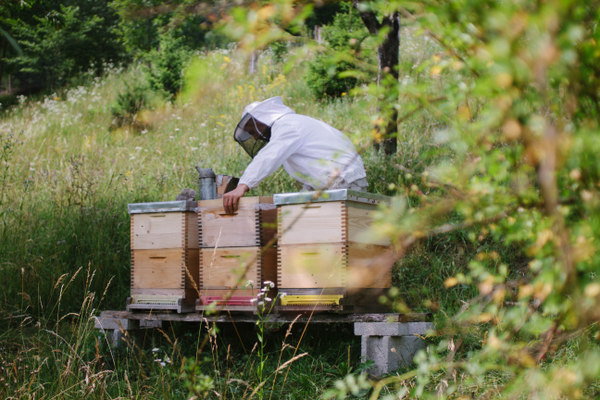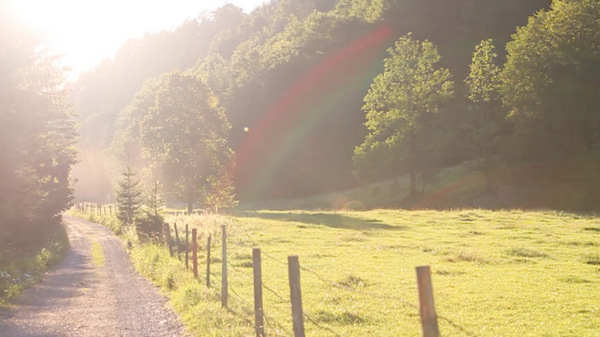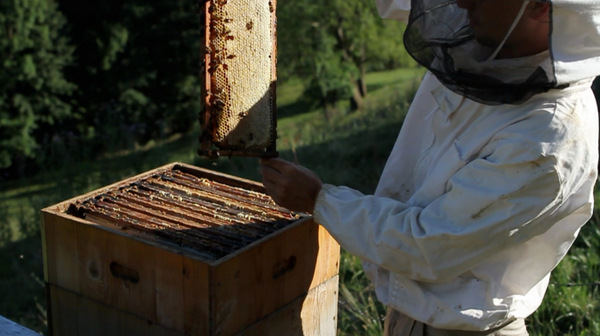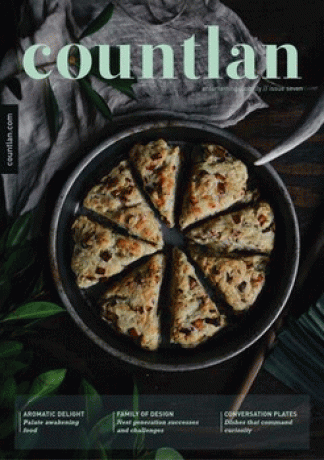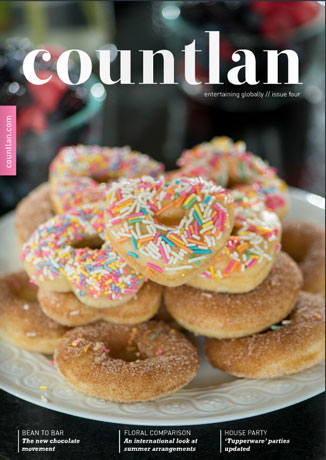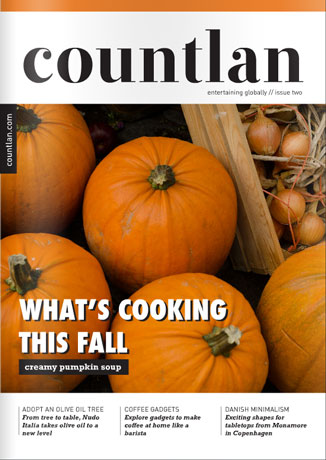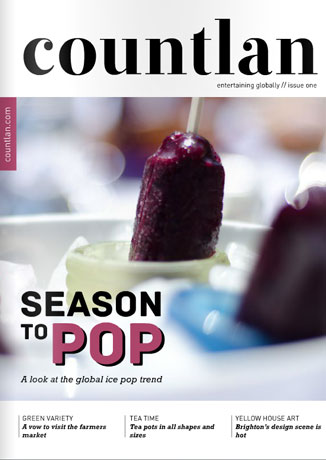
Pressed Honey: Mein Honig
Mein Honig, a small honey startup that launched in Upper Austria’s Kalkalpen National Park, is the story of six individuals, 20 bee hives and a honey making technique connected to an indigenous warrior tribe in the Amazon forest in Brazil. It started with David, a nature loving, self-taught beekeeper, who inherited three bee hives from his father when he was 13 years old. David, influenced by his father who had lived with the Rikbaktsa tribe in the Amazon for a few years, travelled to Brazil to learn about his father’s past. It was in Brazil where David studied the Rikbaktsa tradition of making pressed honey.
Back in Austria, he assembled a team who shared the same ecological and economic concerns to raise awareness of the importance of bees in the ecosystem. Together they embarked on creating a pressed honey of their own. From its packaging to the honey, everything about Mein Honig is hand made and a labour of love. “I spend evenings covering the caps with our special paper. I walk through the fields looking for lavender to dry and put in our Bienenpatenschaft boxes, an opportunity to sponsor a Queen Bee and receive the honey from the colony’s seasonal production“ says David. The team prefers to keep their pressed honey operation small, in favour of producing a higher quality product; something that David calls pursuing prosperity without growth. “So we would rather stay small and keep our work fun.“
INTERVIEW: David Priller, Co-Founder, Mein Honig {Upper Austria}
01 When was Mein Honig launched?
After a year of development, trial and error, lots of fun and a bachelor thesis, we sold the first honey as Christmas presents in December 2012. In January 2013 we gave away our very first „Bienenpatenschaft“ (where customers can adopt a queen bee) – soon 10 more followed. In spring 2013 we launched our Facebook page and website.
02 Where is the Mein Honig team based?
Our bees are based in Upper Austria in the Kalkalpen Natural Reserve Park, far away from monoculture fields and pesticides. It is here, the bees feast on a variety of flowers, grass and other plants – an abundant mix of natural food.
I (David) was born in Upper Austria but moved to Vienna when I started my studies in agriculture. Carina was born and raised in Vienna. We however decided to „go green“ again and moved into a 300 year-old forester’s house, the birth house of (quite famous) Austrian writer Marlen Haushofer. The house has no central heating but masonry heaters in every room and a tiled stove on which we cook. We „share“ the house and stable with our dog Balu, a cat and her four kittens, two geese, 12 sheep, around 30 chicken and three cocks. And, of course, our bees – although we are travelling beekeepers and take them wherever they find food. The others are mainly based in Vienna, although Michael lives in London at the moment and Thomas Grisold is going to study Cognitive Science in Zagreb from September to January.
03 Why urban honey? What is the significance or importance of urban apiaries to you?
I was brought up in a household that some would describe as a family of „treehuggers“. I have an ecological mindset and I am devoted to preserving nature. As a hobby farmer and CEO of the „Stiftung für Natur“ (an NPO in the field of nature preservation) I tried to combine ecological and economical concerns – and to raise awareness that our current economic system will collapse if we fail to concede animals and nature the right to exist. With our bees, we seek to combine these factors: healthy bees are certainly the basis for healthy crops, and flowers. Bees are an economic driving force (remember the film „More than honey“) and bees connect children (and adults) with their food. They help reveal the hidden stories about how our food is grown.
From March to July, 60 children visited our bee hives ( school classes and interest groups) and get to know our bees.
04 What type of information is missing in the minds of consumers when it comes to purchasing honey?
If you buy your honey in a large food shop, you are almost always buying a product that contains honey from up to 10 different countries that gets mixed into one jar. You have to be really careful about the production processes of honey and find out about the location of the bee hives due to issues such as monoculture (the immune system of bees does not do well when they forage from a single pollen source) and pesticides. We think that honey – like sugar –is only seen as a sweetener. People don’t know much about the other side of honey. It is a domestic remedy for all kinds of sicknesses and they see bees as the annoying insects that bother you while eating your bread with jelly. However, thanks to recent publicity and media attention, people want to know more about bees.
05 Can you talk about the identity and values of Mein Honig?
Mein Honig is a blend of our six lives. It is a part of David, nature lover, a part of Carina, urban child turned devoted hobby farmer, Thomas Lichtblau, design and honey addict, Thomas Grisold and Paul Horvath, incarnation of urban dwellers with a foible for extended week-ends at the forester’s house feasting on loads of honey and Michael who turns all the crazy design ideas in „tangible“ websites.
Everything in the Mein Honig brand hand-made. The honey, of course is hand made but the packaging is too. I spend evenings and nights covering the caps with our special paper. I walk through the fields looking for lavender to dry and put in our „Bienenpatenschaft“ boxes. The boys invented a „henry-fordesque“ production line to manufacture our labels and every now and then, we all get together to tackle a new bee project.
Thomas Lichtblau made a huge effort to mirror the essence of our honey in the brand identity: untouched nature, careful harvesting, putting the bees’ well-being before profit. Buying Mein Honig, our customers should immediately see the heart and soul we put in the production of both the honey and the packaging. The should see that our honey embodies a special life style – getting away from over-stimulation: Visually (reduced design) and what regards taste- We don’t offer flavoured honey or single-origin honey. Our honey reflects the mix of nature found in the Kalkalpen nature reserve.
06 How many bee hives do you work with?
We currently have 20 bee hives. We want to expand in the future, but at the same time pursue a „prosperity without growth“ perspective. The production process, the pressing of the honey, is time-consuming and we don’t want to compromise on quality. So we rather stay small and keep our work fun.
07 What was the most significant thing you learned about honey or bees from launching Mein Honig?
I think that I can speak for everyone by saying that we learned that working together with a group of different people is a challenge but it is the best way to create something really special. It was so much fun getting to know the others and combining our wishes into one shared vision.
What really surprised us was that Mein Honig was not seen as a nice after-works project by our customers. They really took to our four types of honey and our „Bienenpatenschaft“. With the interest our customers showed in the life of bees, we started email updates to keep them informed. Today we have „bee parents“ from Switzerland to Moscow! That is the the most impressive lesson learned. You can inspire people to get interested in something that you would never assume would would draw people from the woodwork.

Photo Source: Mein Honig
09 What is your favourite way to eat honey?
Well, my favorite way is to get up at 4.30 in the morning, go to the bee hives and then eat a little bit of honey comb. I love to chew my warm honey comb at dawn and watch the bees start their daily business. The boys would argue that this is certainly nice nibbling, but that the real delight is from eating fresh home-made bread with butter (from the neighbor, who is a farmer too) and honey, sipping a cup of coffee.
10 How would you describe the flavour of the honey you produce?
Pressed honey differs in taste as it contains more pollen and bee wax than traditional honey. People say that the taste „explodes“ in your mouth.
What Mein Honig Produces:
CREAMED HONEY:
Our creamed honey best develops its blossomy taste when served for breakfast. We love it as a bread spread or with sliced fruits. Works perfectly with kids (no spilling).
WILDFLOWER HONEY:
Our bees live and work in a nature reserve with a wide variety of flowers and grasses. That‘s why our wildflower honey tastes mild, sweet, and blossomy – all at the same time. Its light color and high proportion of vitamins make it a perfect „first-aid-honey“ when you have a cold. Just put it in your tea and you‘ll feel better in a minute.
WILDFLOWER/FOREST HONEY:
It‘s the pick of the basket: the combination of wildflower honey and forest honey, vitamins and minerals, delicate fragrance and mild taste. This is David‘s favorite honey.
FOREST HONEY:
This one is special. Our bees go to the deepest woods to gather it. Its sweet and herb-rich taste fits perfectly well with wine and cheese.
11 Where is Mein Honig available?
You can order Mein Honig from our webshop or send us an email. We love it when our customers come visit us at the forester’s house and spend a couple of hours with us. We decided not to sell our honey in large food chains but are currently picking out a few small shops and restaurants with devoted owners and chefs who share our vision.
Recipes with Honey, Honey and More Honey
- The Cooking Doctor: Honey Almond Cake
- Eats Well With Others: Pistachio Cake with Honey Vanilla Buttercream
- Bowl of Delicious: Coconut, Cardamom and Almond Granola
- Southbourne Gardens: Caramelised Shallots
- Needs Salt: Homemade Cinnamon Honey Graham Crackers
- Foodaki: Semolina Halva with Orange and Spices
- Table: Honey Goat Cheese with Dates and Walnuts

